by Steve Cunningham
A full three years after giving us version 6, Digidesign now presents us with Pro Tools 7 for HD, LE, and M-Powered systems. Pro Tools 7 is probably the most significant update to this venerable program since version 5, since it includes a major overhaul of the menus and user interface, as well as some useful new features.
Those of you who have been with these columns for awhile know that I never buy or recommend version #1 of anything — I’m a fan of stability, and like to wait until others have found any land mines that may exist in the newest versions of software. But the changes in Pro Tools 7 are compelling enough, and the land mines few enough, that despite that, I’ve been upgrading not only my VO and casting clients to version 7, but also the couple dozen rigs at the university so I can teach the new version this semester.
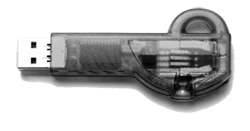 Version 7 is a paid upgrade for existing users, and if you have a Pro Tools HD system you now will need an iLok USB dongle to authorize the program (figure 1). Even if you don’t have an HD rig, iLok is required for several of Digidesign’s better plug-ins, including the excellent Smack compressor/limiter, as well as many third party plugs. If you’re a Pro Tools user, you’re gonna buy the $40 dongle — it’s just a matter of when.
Version 7 is a paid upgrade for existing users, and if you have a Pro Tools HD system you now will need an iLok USB dongle to authorize the program (figure 1). Even if you don’t have an HD rig, iLok is required for several of Digidesign’s better plug-ins, including the excellent Smack compressor/limiter, as well as many third party plugs. If you’re a Pro Tools user, you’re gonna buy the $40 dongle — it’s just a matter of when.
I installed Pro Tools 7 LE over my existing 6.9.2 version on the Mac, and over my existing m-Powered 6.8 version on the PC. Other than the snazzy new icons and new splash screen, the process is identical to previous installations.
 WHAT’S NEW
WHAT’S NEW
Version 7 marks the introduction of the .ptf session file format in place of the older .pts format. This new format eliminates the compatibility issues between PC and Macintosh session files, so the PC/Mac compatibility checkbox is gone. In addition, all .ptf session files have +12dB of gain (at the top of the fader) only, whereas version 6.9 allowed you to choose between the original default of +6dB and the then-new +12dB range. By the way, the +12dB setting was aimed at Avid video users, and just scaled the top of the fader travel a bit differently — the maximum gain hasn’t really changed, and your headroom still depends on which interface you use. The mBox has +12dBu of headroom, the 002 has +18dBu, and the 192 has +22dBu.
Because the new .ptf format works only on Pro Tools 7, you must save your session as .pts if you need to use it with an earlier version of Pro Tools. The good news is that the Save Copy In command allows you to save in formats going all the way back to version 3.2. Moreover, filenames are no longer limited to 31 characters, and it looks like the nasty long file path errors are history.
But converting old sessions from version 6 to version 7 is not always simple on TDM systems. Those of you with larger Pro Tools rigs will find that the DSP Manager works differently in version 7, and according to Digidesign this difference is part of what makes version 7 so much more DSP-efficient. However, early reports from the field indicate that opening version 6 sessions sometimes results in out-of-DSP errors, with the result that many of the session’s plug-ins don’t load properly, and manually re-allocating the plug-ins doesn’t seem to help. The workaround for this is to open the version 6 session, ignore the error messages, then quit Pro Tools without saving the session. Restarting Pro Tools then allows the old session to be opened successfully, with all plug-ins intact. This minor problem should be fixed in a future release, so be sure you get the latest from Digidesign’s website. At this writing, current versions are 7.1cs3 for HD, 7.0cs3 for LE, and 7.0cs3 for m-Powered.
Also new is support for ten aux sends per mixer channel, up from five sends previously (figure 2). The sends are organized as two blocks of five each, so you don’t have to waste screen space for sends you’re not using. The number of inserts per channel remains at five each.
For HD users, one of the biggest changes is the end of the HTDM plug-in format. HTDM was introduced in Pro Tools 5 as a way of integrating host-based plugs (those that use the computer’s CPU rather than Pro Tools’ DSP to do their work) into TDM systems. HTDM was always a dicey proposition, since the plugs were often unstable, and third-party plug developers treated HTDM as the step-child of their RTAS products.
In Pro Tools 7 HD, you can now use RTAS plug-ins both before and after TDM plug-ins on aux tracks and audio tracks, as well as on Master Fader tracks. There is a penalty though, in that using RTAS plugs in HD systems use voices to transfer audio to and from the TDM world. So if you have a stereo aux that takes its input from an audio interface and you stick a stereo RTAS plug on the aux, you’ll end up using four voices instead of two. Since HD systems provide a large number of voices anyway, this should only be an issue on very large sessions.
One final note for HD users — the DAE in Pro Tools 7 doesn’t work with some third-party editors, notably Apple’s Logic Pro and MOTU’s Digital Performer. Hopefully this will be addressed in future versions of the software.
THE BIG REORG
Once you’ve opened a session in Pro Tools 7, you’ll see that it doesn’t look much different than version 6 at first glance. But look around — the old neighborhood has changed.
Evidently Digidesign has been listening to its end users, at least in some areas. The improvements are most evident in the menu system, which has always been a pet peeve of mine. Previous versions of Pro Tools have evolved by sticking new functions under menus that often made little sense — for example, I’ve always hated the Display versus Windows menus. See, you used the Display menus to choose what parameters would be visible in say the Mix window, then used the Windows menu to make the Mix window actually appear in front. Perhaps it was just the poor choice of terms, or the fact that they were right next to one another, but it didn’t work for me.

Figure 3 shows the version 7 menu bar above the menu bar from version 6. As you can see, the new menu bar is much better organized based on how we all work. The Window menu is still where you make the Mix window come to the front, but the Displays menu is replaced by the View menu, which is now located on the left side (figure 4). The new Track menu is where you create, duplicate, and delete tracks, which makes far more sense than having those functions under the File menu as they were in version 6.
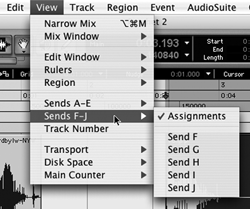
Please note that while most of the illustrations here are taken from a Macintosh, the Windows XP version of Pro Tools 7 looks identical. In fact, there are those who argue that Pro Tools is now more stable and substantially faster on a Windows XP machine than it is on a Mac, which amounts to a one-eighty turn from the situation a few years back. It will be interesting to see how that plays out on the new Intel-powered Macs.
The Duplicate track function now asks you to specify exactly what you want duplicated — just audio, or audio plus automation, sends, groups, etc. — as well as how many copies you want. The old Show/Hide list is now known as the Track List, and has extra options for organizing your tracks by groups, name, and so forth.
There’s more... the much-used Import Audio function used to be nearly impossible to find on the little gray bar above the right-hand Region list. Never mind the fact that that gray bar was simply labeled Audio and looked like a decorative element until you clicked on it and revealed the drop-down menus. It also made that function difficult if not impossible to script with a macro program like Quickeys, since that drop-down wasn’t part of any organized menu structure. You had to write the macro to click-and-hold at a certain point on that window, and hope for the best.
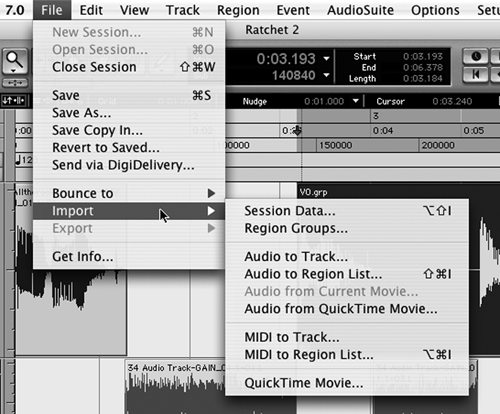
Import is now underneath the File menu where it belongs in version 7 (see figure 5). Better yet, the Import menu has submenus attached to it that among other things makes it simple to decide if you want to import audio just to the region list, or have Pro Tools automatically create an appropriate audio track and place it there.
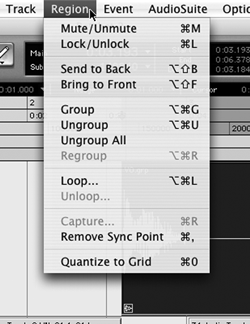 One new feature that makes me happy is the ability to group audio regions, a function that exists in several other high-end editors but has been lacking here (figure 6). Located under the new Region menu, the Group command essentially turns two separate audio regions into one for purposes of moving, editing or muting, without having to use the Consolidate function that re-writes the selected regions into a whole new audio file. Of course, these regions can be ungrouped later, but meanwhile they remain as a new region in the Region list and so can be used again on a track as a grouped unit. Nice.
One new feature that makes me happy is the ability to group audio regions, a function that exists in several other high-end editors but has been lacking here (figure 6). Located under the new Region menu, the Group command essentially turns two separate audio regions into one for purposes of moving, editing or muting, without having to use the Consolidate function that re-writes the selected regions into a whole new audio file. Of course, these regions can be ungrouped later, but meanwhile they remain as a new region in the Region list and so can be used again on a track as a grouped unit. Nice.
Gimme a big “hallelujah!” here: Pro Tools 7 supports up to 999 memory locations (that’s Markers to you), up from the previous 200. I can’t tell you how long that’s been an issue for me, particularly when marking fluffs in a four-hour VO session.
There are a lot of little things that make Pro Tools 7 a pleasure. For example, you can now resize the I/O window, which is very handy when you have multiple monitors or a large number of physical inputs and outputs. You can now drag and copy Send slot assignments to different mixer channels, in the same way you do on insert plug-ins. This makes setting up a cue mix a quick process.
You can now drag and drop audio files directly from the desktop into the Region list, a real time-saver. And when adding multiple Regions to the Edit window you can choose whether each goes on a separate track, or each is stacked in series on the same track. Finally, enabling a new option called Link Track and Edit Selection automatically selects the Track when you click on a Region within that track.
Unfortunately we didn’t get one feature that we really need, and that’s audio bins or folders that help organize regions. It’s not uncommon for me to end up with several hundred regions at the end of an intense promo with lots of edits, and all those regions end up just sitting in that loooong region list on the right. Sure, I can sort them by timestamp or alphanumerically, but what I really need to do is plop all the VO regions into a folder within the region list, and do the same with the music and with the sound effects. Maybe next time...
NEW PLUG-INS
Although technically not new, since they were released as free upgrades for Pro Tools version 6.9, Digidesign has given us two new standard plug-ins that represent substantial improvements on the older versions.
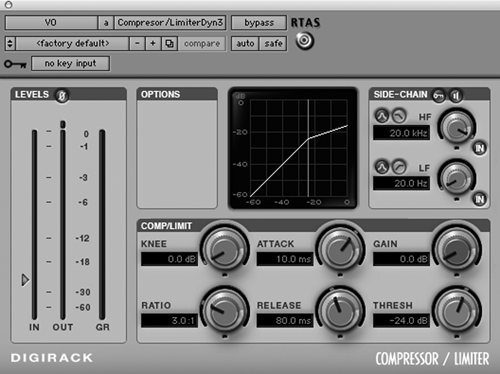
Dynamics III represents a step forward, not only in terms of the user interface (see figure 7), but also in terms of sound. The old version was typical of early digital compressor plugs — it works okay, but it was sterile and often abrupt. Dynamics III is much smoother sounding, and while it doesn’t have much in the way of “character,” it’s processing is far more subtle, even when pushed.
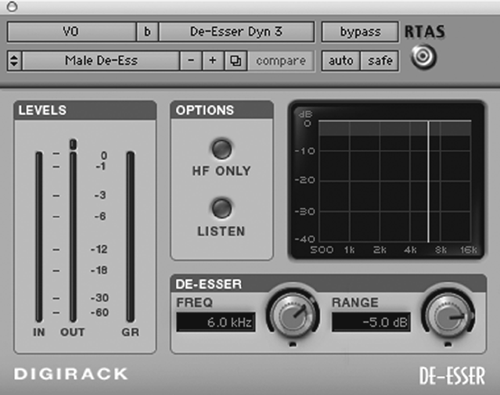
Like the previous Dynamics II, Dynamics III comes configured three ways — as a compressor/limiter, and expander/gate, and a de-esser. (Y’all know that those are all just re-jiggered compressors, doncha? ‘cause they are.) But as you can see from figures 8 and 9, they’re substantially more useable and give you a far clearer picture of what’s going on at any given moment.
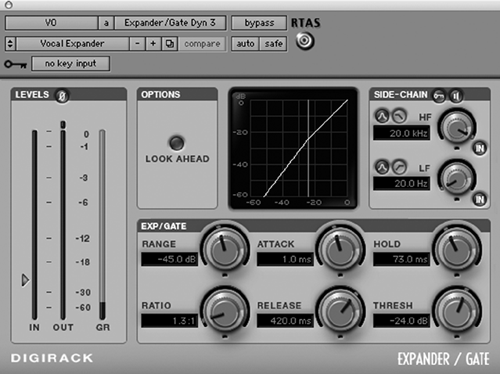
The other upgraded plug-in is EQ III, the first really good-sounding equalizer ever included with Pro Tools. It’s available in one-, four-, and seven-band versions, and each includes both a high-pass and a low-pass filter. As with Dynamics III, the interface presents settings in a clear and concise fashion that make it immediately useable. Did I mention that it sounds good? EQ III competes well with third-party EQs, and goes easy on the CPU to boot. I like it.
Because of the architectural changes to Pro Tools, not all third-party plug-ins have as yet been updated to run on version 7. This is because Pro Tools 7 has changed the plug-in executable format on both platforms to improve efficiency, and on HD systems the DSP-manager has been changed for the same reason. So one way or the other, you’re likely to need updates to all of your plugs within the next year.
Digidesign maintains a complete list of compatible and incompatible plugs at www.digidesign.com/developers/plugin_info/grid/, and as of this writing there are more compatible than incompatible plug-ins displayed there. But I’ll definitely have to update my Waves plugs, along with the Sony Oxford compressors.
TO UPGRADE OR NOT
I don’t think this should even be a question. If you’re a Pro Tools user, the upgrade to version 7 is a must-have. Pro Tools is truly an industry standard, and one look at the DAW Network on www.rapmag.com will tell you that there are more Pro Tools users in production than ever. The upgrade for LE and m-Powered versions is $75 US, and for HD users the price is $150 US. If you’re one of those users, Steve sez go do it. If you’re on the fence about Pro Tools, version 7 may be just the thing to push you over.
For more information, visit www.digidesign.com.
♦

